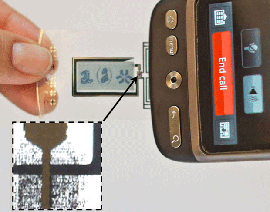A printed diode rectifies a radio signal from a smartphone to power an electrochromic display.
 One day, your smartphone will have conversations with your refrigerator, and your car will ask a city’s streets for tip-offs about free parking spaces. The ‘Internet of Things’ describes a world where pretty much everything is connected to everything else, enabling myriad applications from streamlined shopping to energy conservation.
One day, your smartphone will have conversations with your refrigerator, and your car will ask a city’s streets for tip-offs about free parking spaces. The ‘Internet of Things’ describes a world where pretty much everything is connected to everything else, enabling myriad applications from streamlined shopping to energy conservation.
It’s easy to imagine giving home appliances the hardware needed to plug into the Internet of Things – but what about a T-shirt, a magazine, or even an orange? These things need electronic labels—flexible, printed electronics that can draw power from their environments and use it to dispense useful information about the object.
A research team based in Sweden and the UK has now created the first printed e-label than can communicate with a smartphone. As a proof of principle, the device harvests energy from the smartphone’s signal, and uses it to illuminate a small display. The device was unveiled today in the Proceedings of the National Academy of Sciences of the United States of America.
Smartphones typically transmit and receive signals in the ultra-high frequency (UHF) band, spanning 300 MHz to about 3 GHz, and previous e-labels have struggled to pick up those frequencies. Organic semiconductors, for example, can be printed onto flexible substrates to make components such as diodes and transistors, but in most of them charge moves sluggishly—reducing their operating frequencies. Laying down the organic semiconductor films under high vacuum can improve charge carrier mobility, but it makes the labels much more expensive to mass-produce. Nanoparticle semiconductor inks, in contrast, are more suitable for high-frequency work, but most require extreme heat treatments that would destroy flexible plastic or paper backing.
The solution is a printable Schottky diode that combines the best aspects of both technologies to pick up higher frequencies. “This is the first time anyone has done anything like this in the gigahertz region,” says Göran Gustafsson, a materials scientist at the Norrköping branch of the Acreo Swedish ICT research institution. “This is the starting point of having paper connected to the internet.”
To build the device, the researchers took crystalline silicon wafers, doped with antimony, and crushed them into particles that were mostly between 100 nanometers and 1 micrometres across. They then mixed the particles with a polymer binder, and printed them onto an aluminum electrode. Next they added a protective layer of niobium silicide microparticles, which are highly conductive and resistant to oxidation. Finally, they topped the device with a carbon electrode and a layer of silver paste. The process only needs a brief, mild heat treatment, and can be done in the open air.
Teamed with an aluminium foil antenna, the diode harvests UHF radio waves and rectifies them into a direct current. Performance declined above 1.6 GHz or so, but it could still draw enough power from a 1.8 GHz smartphone signal to generate a current of 19 microamps. That was sufficient to power on a printed, electrochromic polymer display.
“The original idea was the make a security code on a banknote,” explainsMagnus Berggren, a materials scientist at Linköping University, Norrköping, Sweden, and part of the research team. In theory, a smartphone held close to the banknote would be able to identify the e-label, which might hold information about the origin of the note and should be difficult to counterfeit. British company De La Rue, the world’s largest banknote and passport manufacturer was also part of the research team.
It should be possible for such an e-label use the harvested power to send a signal back to a smartphone, adds Gustafsson. But for now, the researchers are working on reducing the cost of the diode – replacing the niobium silicide layer would be a good start – and pushing the operating frequency up to 2.4 GHz, the standard used by Wi-Fi routers and Bluetooth devices.






